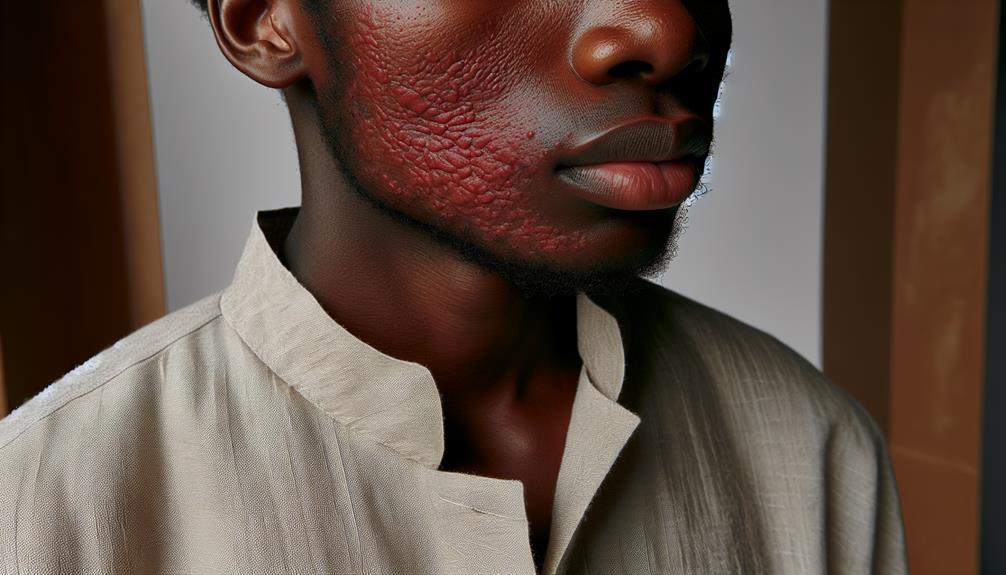Linen can feel itchy due to its natural rough fibers and lack of stretch, causing irritation on sensitive skin. Factors like yarn thickness and production chemicals can also contribute to its scratchiness. To minimize discomfort, washing with mild detergent, opting for high-quality linen, and using fabric conditioner can help soften the fabric. Understanding the structure of linen fibers and skin sensitivity is essential for a more comfortable wear. Discovering how softening methods transform linen can enhance overall comfort. Explore further to reveal the secrets behind linen's itchiness and ways to make it feel luxurious on your skin.
Table of Contents
Key Takeaways
- Linen fibers have natural irregularities that may feel rough and cause skin irritation.
- Lack of elasticity in linen leads to initial stiffness and roughness compared to cotton.
- Factors like yarn thickness, weave structure, and chemical treatments affect linen texture.
- Residues from the retting process can contribute to linen roughness.
- Washing linen with mild detergent, using fabric softener, and opting for high-quality linen can minimize itchiness.
Linen Fibers and Skin Irritation
When wearing linen garments, you might notice that the fabric feels slightly rough against your skin at first due to the natural irregularities in linen fibers. These irregularities, derived from the flax plant, can create a somewhat stiff and abrasive texture. Some individuals may experience skin irritation or itchiness when wearing new linen due to the coarseness of these fibers. However, fret not, as the itchiness can be alleviated over time through the washing process. As you launder your linen pieces, the fibers soften, becoming more comfortable against your skin.
Moreover, factors such as yarn thickness and weave structure also play a role in determining the overall feel of linen fabric. Thicker yarns and looser weaves might result in a rougher texture, while finer yarns and tighter weaves could yield a smoother, less irritating feel. So, if you find your linen garments initially itchy, remember that a few washes and wears can greatly improve their comfort level.
Impact of Production Process on Texture
Exploring how the production process influences linen's texture sheds light on why some linen garments may feel rough or itchy initially. Linen fabric, known for being a natural fabric made from flax fibers, undergoes various treatments during production that can impact its feel.
European linen, prized for its quality, often goes through a softening process to enhance its texture. However, some manufacturers may use chemical softeners that, when not properly washed out, can lead to residual stiffness, causing discomfort. Additionally, the retting process used to extract flax fibers can sometimes leave behind residues contributing to the initial roughness of linen.
The inherent stiffness and lack of elasticity in linen fibers also play a role in its scratchy feel. Understanding these aspects of linen production can help consumers make informed choices when selecting linen garments and prompt them to contemplate using fabric softeners to enhance the fabric's comfort.
Flexibility Comparison With Cotton
Comparing the flexibility of linen with cotton reveals why cotton is often favored for its smoother and softer feel against the skin. Cotton fibers are known for their flexibility and elasticity, making them more pliable and gentle on the skin compared to the rough texture of linen fibers. The inherent softness and stretch of cotton contribute to a fabric that's less likely to cause irritation or itchiness, especially for those with sensitive skin.
In contrast, linen fibers lack the same level of elasticity, resulting in a coarser and less flexible material. This lack of flexibility in linen can lead to initial stiffness and roughness, which may feel scratchy and uncomfortable against the skin, causing irritation and itchiness. When new, linen's inflexible nature can be more pronounced, highlighting the stark difference in feel between linen and cotton fabrics. Ultimately, the greater flexibility and softness of cotton fibers make it a preferred choice over linen for those seeking a more comfortable and skin-friendly textile option.
Minimizing Linen Itchiness Tips
To alleviate linen itchiness, consider implementing these practical tips for a more comfortable wearing experience. Linen's natural fibers can initially feel stiff and coarse, leading to itchiness. Washing your linen garments with a mild detergent and fabric softener can help soften the fabric over time. Opting for high-quality European linen may also minimize itchiness, as it tends to be softer and more refined.
Additionally, using a fabric conditioner specially designed for linen can further soften the fabric and reduce discomfort. If you prefer immediate relief, choosing pre-washed or pre-softened linen products can provide a smoother and less itchy feel right from the start. By incorporating these tips into your linen care routine, you can enjoy the breathability and durability of this fabric without the unwanted itchiness.
The Science Behind Linen Itchiness
So, why does linen sometimes feel itchy against our skin?
Let's uncover the science behind this common discomfort.
Understanding the structure of linen fibers and how they interact with our skin's sensitivity can shed light on why linen can be scratchy for some individuals.
Linen Fiber Structure
Understanding the intricate structure of linen fibers is key to unraveling the mystery behind why linen can sometimes feel itchy on the skin. Linen fibers, being natural fibers, have irregular structures with tiny 'nodes' that can initially feel scratchy. The short fibers in linen can protrude from the fabric, causing irritation and leading to itchiness.
Additionally, linen's inherent stiffness and lack of elasticity contribute to its rough texture, which may not be well-received by individuals with sensitive skin. However, the roughness of linen fibers can be lessened through various softening techniques like washing and wear.
It's important to take into account the interaction between linen's unique fiber structure and individual skin sensitivity when addressing the potential itchiness experienced with this fabric.
Skin Sensitivity Factors
Linen's itchiness can often be traced back to the unique sensitivity of individual skin to its natural fibers and the initial stiffness characteristic of the fabric. The rough texture of linen, derived from the flax plant fibers, can feel scratchy on sensitive skin, causing discomfort. New linen garments may feel stiff, exacerbating the itchiness, but this typically diminishes with wear and washing as the fabric softens.
Various factors like weave, yarn size, and finishing techniques play a role in determining the level of roughness of linen fabrics, impacting their itchiness. Understanding these skin sensitivity factors enables one to choose softer linen products or apply softening techniques to alleviate discomfort, ensuring a more pleasant wearing experience.
Linen Itchiness: New Vs. Aged
Often, new linen can feel itchy due to the natural fibers' stiffness, causing discomfort against the skin. However, as linen ages, it tends to become softer and less irritating. Here are some key differences between new and aged linen concerning itchiness:
- New Linen:
- Initially stiff fibers
- Prone to causing itchiness against the skin
- May feel rough and abrasive
- Requires some time and care to soften
Aged Linen:
- Softened fibers through wear and washing
- Reduced likelihood of causing skin irritation
- Develops a smoother texture over time
- Generally more comfortable to wear
Understanding the evolution of linen from new to aged can help manage expectations regarding its initial itchiness. With proper care and use, linen bedding and clothing can transform into a cozy and gentle fabric choice.
Softening Methods for Linen
To soften linen and reduce its itchiness, incorporating natural fabric softeners like vinegar or baking soda into the washing routine can be highly effective without causing damage to the fibers. When washing linen sheets, using warm water and a gentle washing cycle can also help maintain their softness. Here are some methods to soften linen effectively:
| Softening Method | Instructions | Benefits |
|---|---|---|
| Vinegar | Add 1/2 cup of white vinegar during the rinse cycle | Softens linen and removes any residue |
| Baking Soda | Sprinkle 1/4 cup of baking soda before washing | Acts as a natural fabric softener |
| Dryer Balls | Toss in a few wool dryer balls during drying | Helps fluff up linen and reduce stiffness |
| Fabric Softener | Use a natural, unscented fabric softener | Adds extra softness without harsh chemicals |
| Air Drying | Hang linen sheets to air dry | Helps maintain the fabric's texture |
Factors Affecting Linen Itchiness
Factors that contribute to the itchiness of linen include the natural stiffness of its fibers and the quality of craftsmanship during production. When linen yarn is spun, the fibers retain some rigidity, causing initial discomfort. Additionally, the roughness of new linen items can vary depending on how well they were crafted.
The texture of linen, derived from the flax plant, adds to its unique feel, which can sometimes be scratchy. To reduce itchiness, proper linen care is essential. Washing linen gets rid of impurities and residual chemicals, while using low heat to dry it until still slightly damp helps break down the fibers for a softer touch.
Softening linen through use and washing gradually enhances comfort, making it more enjoyable to wear. European linen, known for its plush and supple feel, remains a popular choice despite the initial itchiness it may present.
Benefits of Softened Linen
Softened linen enhances the overall comfort and wearability of the fabric, making it a luxurious choice for individuals seeking a softer touch. By reducing scratchiness and stiffness, softened linen guarantees a gentle feel against the skin, ideal for those with sensitive skin. The process of softening linen not only improves comfort but also extends the fabric's longevity, enhancing its wearability for years to come. For individuals looking to elevate their everyday experiences, softened linen provides an indulgent feel that adds a touch of luxury to any setting.
Investing in softened linen not only benefits personal comfort but also supports sustainable and socially responsible textile practices. Opting for Oeko-Tex certified softened linen assures that the fabric meets stringent environmental and social criteria, ensuring that your choice aligns with ethical standards. Embracing softened linen isn't just about indulging in comfort; it's also a conscious decision to promote sustainability in the textile industry.
Frequently Asked Questions
How Do You Make Linen Less Itchy?
To make linen less itchy, I wash it with gentle detergent and fabric softener, add white vinegar to the rinse, and tumble dry with dryer balls. Choosing pre-washed linen or products can also reduce initial itchiness.
Is Linen Meant to Be Scratchy?
Linen can feel scratchy initially because of its natural fibers' coarseness. Over time, with use and washing, linen softens, becoming more comfortable. The rough texture is a sign of authenticity and unique natural characteristics.
Why Are Linen Sheets Itchy?
Linen sheets can feel itchy due to the natural fibers' rough texture. Initial stiffness adds to the scratchy feel. Linen, from the flax plant, can irritate some. Quality and craftsmanship affect roughness. Softening linen through washing and use helps reduce itchiness.
Does Linen Get Softer the More You Wear It?
Wearing linen frequently provides increased softness as the fibers break down over time. With proper care, linen becomes more comfortable against the skin. Regular use and laundering enhance the luxurious feel of European linen.
- The Use of Nonwovens in Construction and Civil Engineering - July 11, 2025
- The Use of Nonwovens in Construction and Civil Engineering - July 11, 2025
- The Use of Nonwovens in Construction and Civil Engineering - July 11, 2025






